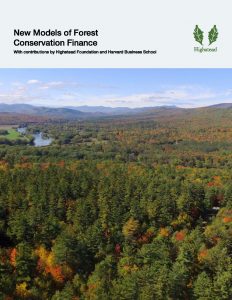The accelerating climate crisis heightens the urgency of investing in the protection and expansion of forests, making conservation finance solutions increasingly important.
Forest land is critically important to our survival and is disappearing at an alarming rate. Forest conservation presents a compelling opportunity to address the climate crisis and it can present an equally compelling investment opportunity.
At Highstead and throughout our Wildlands, Woodlands, Farmlands and Communities (WWFC) network, we seek new approaches to financing forest and farmland conservation, knowing its critical importance to our land conservation goals. We are partnering with NGOs, financiers, public agencies and academics to identify, research and pilot forest finance mechanisms. Out of this desire, came a fruitful collaboration with Josh Lerner, the Jacob H. Schiff Professor of Investment Banking at Harvard Business School. Professor Lerner’s growing interest and practice in impact investing and forest finance brings us important insights that bridge the finance and conservation spheres.
Along with his very capable MBA students, Andrew Baxter, Connor Cash and Ratnika Prasad, Professor Lerner dove into two fascinating case studies on how impact investors see forest investments as an opportunity to do well, while doing good.
In the first case study, the authors investigate a novel green bond that has promise to accelerate the protection of working forestland. This case study is of particular interest to us at Highstead because The Conservation Fund is using some of the proceeds from its green bond to invest in timberland in southwestern Maine, the very same region where our Sebago Clean Waters partnership is focused. The Sebago Clean Waters initiative–which Highstead helped to establish–is a water fund and conservation partnership between the Portland Water District and eight environmental NGOs, with a mission to protect water quality, community well-being, a vibrant economy, and fish and wildlife habitat in the Sebago watershed through voluntary forestland conservation.
The second case study that Professor Lerner and colleagues investigate addresses how to achieve environmental and social impact at scale. Sonen Capital is a fund-of-funds, which effectively screens high-impact, market-rate impact investment funds, which they in turn offer to their investors. One constant lament of conservation finance practitioners, financiers, and conservationists alike is the dearth of access to investment-grade deals that have real conservation impact. The authors go into the details of how a fund-of-funds provides the connection between investor and impact through curated opportunities. And with the growth of sustainable impact funds [spoiler alert] growing at nearly 50%, it is critical to ensure that the intended conservation outcomes go past investor marketing materials and truly come to fruition.
